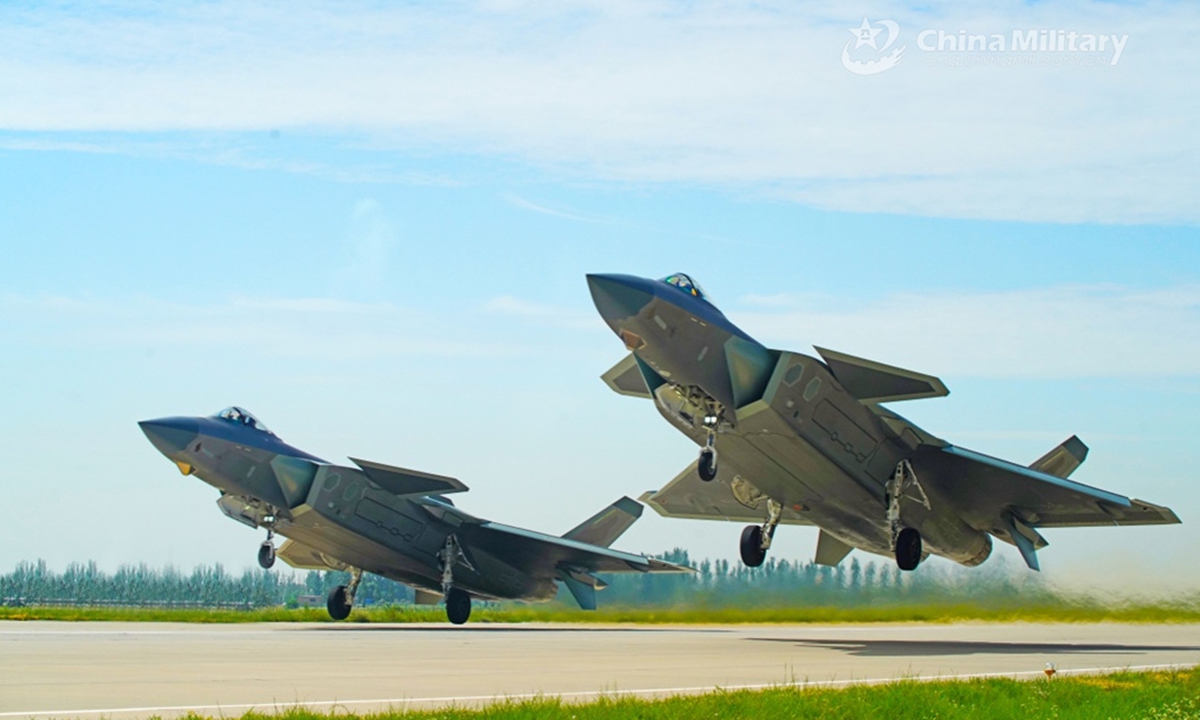It is a coup d état that the US might not have seen coming. After being refused the fifth-generation fighter F-35 Lightning II, its ally, the United Arab Emirates, is reportedly looking at China to bolster its security by exploring its fifth-generation J-20 stealth fighter.
The chances of Chengdu J-20, a twinjet all-weather stealth fighter aircraft developed by China’s Chengdu Aerospace Corporation for the People’s Liberation Army Air Force (PLAAF), becoming a part of the UAE’s fleet are getting stronger by the day.
The UAE’s desire to acquire the F-35 fighter jet in 2020 derailed the normalization of relations with Israel. Israel saw this step as an attempt to undermine its security doctrine of maintaining military superiority in the region.
Israeli security doctrine has long prioritized military superiority over its neighbors by either getting the most advanced military technology from the US or denying it to the countries in its neighborhood.

An article in National Interest argued that “this tension may now drive the UAE towards other potential military suppliers like China.”
Recent UAE-China engagements suggest increasing cooperation, including potential military collaboration, highlighted by the UAE’s interest in Chinese aircraft like the J-20 following their inability to secure the F-35. This shift could reshape regional military dynamics and affect US-Gulf strategic ties,” the article added.
Air force-to-air force ties between the UAE and China have been burgeoning. On April 23, Major General Saleh Mohammed bin Majren Al Ameri, commander of Joint Operations for the UAE, visited Beijing and met with Lt General Chang Dingqiu, commander of the People’s Liberation Army-Air Force (PLAAF), at the headquarters of the Chinese Ministry of Defense.
Opting for J-20 seems plausible, as the UAE has already received the Chinese Falcon L-15 advanced trainer aircraft. The delivery of L-15s is seen as China getting a toehold in the Middle East defense market.
If the UAE chooses the J-20 for its fleet, it would indeed alter the US influence in the region, as we know. The UAE plays an influential role in the Middle East and is a key partner of the United States. They collaborate on various issues, including defense, non-proliferation, trade, law enforcement, energy policy, and cultural exchange.
A Chinese media has claimed that the “appearance of high-end fighters such as the J-20” would challenge the exclusive supply pattern of the US. The article underscores that the UAE and other oil-rich countries in the Middle East have always bought the best weapons for their forces, and considering the US F-22 ‘Raptor’ has been discontinued and “favoritism” appears to be the US sales strategy for F-35 in the Middle East; it is an opportunity for the Chinese fighters to enter the Middle East.
What will be the salt to the wound is that the US has claimed that the J-20 is a rip-off of the American 5th-generation fighter jet program. A 2018 Pentagon news story about the Department of Defense’s annual China report mentions that apparent similarities between the J-20 and F-35 could very well be a result of espionage.
At a glance, the J-20 does appear to show some resemblance to the F-35, particularly the blended wing-body front end and internally built, conformal exhaust pipes.
UAE & US – Lovers’ Spat Or Break Up
Economically, the UAE is the United States’ single largest export market in the Middle East and North Africa region. Over 1,000 US firms operate in the UAE, and many others use it as a regional headquarters for conducting business across the Middle East, North Africa, and parts of Asia.
In terms of security cooperation, the two countries have developed strong government-to-government ties, including close security cooperation. The US has had an ambassador resident in the UAE since 1974.

Another US media publication, The Hill, reported in 2023 that the Emiratis were increasingly leaning towards Russia and China for economic growth and diplomatic leverage. China is the UAE’s largest non-oil trading partner globally, and the UAE is China’s second-largest trading partner.
In 2021, US intelligence found out about China’s secret military facility at a UAE port. The UAE agreed to stop the project at America’s insistence, but the construction was renewed by the end of 2022. Power and water connection, along with the construction of a perimeter wall, has been done for the PLA’s logistics site.
A report in the Washington Post in 2023 indicated that the activities at a port near Abu Dhabi are one of the few instances of the UAE cozying up to the Chinese military at the expense of its longtime ally, the US.
Built under ‘Project 141’, the logistics sites are part of China’s plans to build a global military network of at least five overseas bases and 10 logistical support sites by 2030.
F-35 Vs J-20
The Lockheed Martin F-35 Lightning II and the Chengdu J-20 are two advanced fifth-generation fighter jets.

The F-35 is a single-seat, single-engine, multi-role fighter developed by the United States. It is designed for a wide range of missions, including air-to-air and air-to-ground combat. The J-20, developed by China, is also a fifth-generation fighter with stealth capabilities.
Range-wise, the J-20 is said to have a longer range than the F-35. This enables it to cover vast distances without refueling, a vital factor in strategic air operations.
The J-20 is powered by a homegrown engine called the WS-15 after-burning turbofan. This enables it to reach a maximum speed close to Mach 2 (1,535 miles per hour) with a ceiling of 60,000 feet and a range of nearly 700 miles.
The J-20 is reported to be faster than the F-35. The J-20 is said to be capable of operating at a max speed of Mach 2.0, which is faster than the F-35 speed at Mach 1.6.
The J-20 also has a stand-off missile launch – an ability to stay out of range of enemy air defenses and pickle off missiles beyond visual range. It can carry more weapons than the F-35. J-20 also boasts of having lower operating costs than F-35.
“The J-20 does operate with a “bomb-truck” like capacity to deliver more ordnance than an F-35 on a single mission, as it can take off with 27,998 pounds of internal and external ordnance, compared with an F-35 in beast mode, which can travel with 18,000 pounds of weapons,” US defense expert Kris Osborn has written.
The F-35 has an advantage over the J-20 due to its advanced avionics and sensor suite. The American 5th-generation fighter also has Vertical takeoff and landing capability (VTOL) and a wide mission profile.
In summary, the J-20 has advantages in range, weapons capacity, and stealth, while the F-35 excels in avionics, maneuverability, and versatility. Both aircraft represent cutting-edge technology and redefine air combat capabilities.




